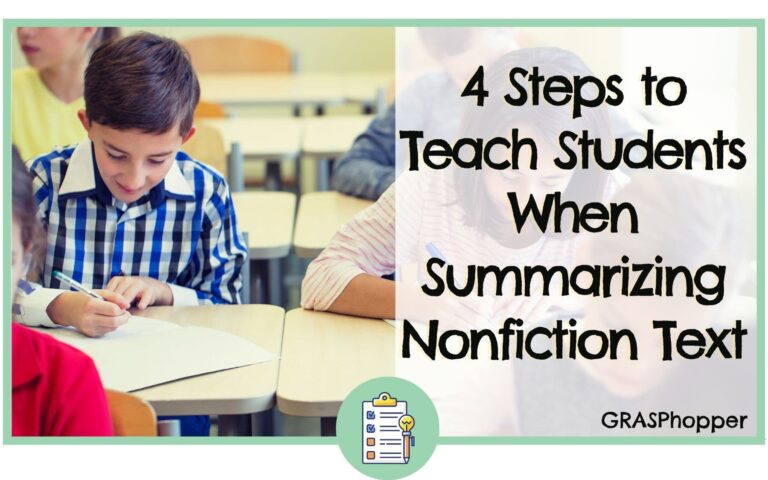Want your students to become experts at writing structured responses? Then you definitely want to keep reading to find out how to teach them to use the RACE Writing Strategy.
The RACE writing strategy is a tool used in education to guide students through the process of crafting thoughtful, structured responses to essay questions or prompts. In a nutshell, it teaches students how to construct a complete response with evidence and their own thinking.
Want to know what RACE stands for, how to teach the strategy and ways to practice this strategy in the classroom? Keep reading because we are diving into all of this!

Understanding the RACE Strategy
When we talk about the RACE writing strategy, we mean a simple and straightforward method that helps students craft detailed and organized responses in writing.
The RACE Strategy Acronym
The purpose of RACE is to provide your students with a clear structure for writing, especially when they are answering questions or even writing essays.
Here’s what each letter in RACE stands for:
- R: Restate the question
- A: Answer the question
- C: Cite the evidence
- E: Explain your thinking
By following these steps, we can teach students to create thorough and well-supported responses that are easy to follow.
Why should you teach this strategy to students?
When you teach this, students will become experts at writing well-structured responses to text-based questions with evidence and clear explanations with the RACE acronym. This will help them on standardized tests and answering short and long essay questions.

Implementing the RACE Writing Strategy
When we discuss writing strategies, RACE is a systematic method we use to help students develop detailed and well-structured written responses. Let’s take a closer look at the steps and what students need to do for each:
1. Restate the Question
First, we always begin by rephrasing the question or prompt in our own words. This step is crucial because it shows we understand what’s being asked. Reiterating it also helps to lay the foundation for a well-organized answer that directly tackles the question.
For example, if students have a question such as “How does photosynthesis benefit plants?” we could teach them to rephrase it like this: “Plants benefit from photosynthesis because…”
2. Answer the Question
Next, the task is to answer the question directly. Clarity is the key here and the goal is to be as specific as possible without beating around the bush. For example, if the question asks for our opinion, we will just say it directly to make sure our answer is clear and easy to understand.
3. Citing Evidence
When we get down to the nitty-gritty of the RACE writing strategy, citing evidence is the chance to show that we’ve done our homework. It’s about backing up your points with solid proof.
Choosing Evidence
We’ve got to be picky when choosing evidence because not all information is created equal. If you are talking about something like climate change, then you have to be careful about what information you use.
Not all facts are the same, so we have to choose the best ones that really support what we’re saying. For example, try using real numbers and information from scientists or even quotes from experts. This helps to make sure that every piece of information we use helps to prove our point.
Integrating Evidence
Now, to really fit the evidence into your writing, use clear, simple sentences to add it in. Here’s a great tip: use phrases like “Purdue University says” or “The author says” to add evidence smoothly. This makes the writing sound natural and not just like a bunch of random facts. It also shows that we’re not just guessing—we’re actually using what we know!
4. Explanation of Evidence
In the RACE writing strategy, after giving evidence, the next step is to dig into explaining what the evidence shows and how it helps to support the answer.
Teach students to ask themselves these questions during the final step of the strategy:
- Did I add evidence to support the answer?
- Did I copy or paraphrase evidence from the text?
- Did I use “quotation marks” if I copied exact words?
Race Strategy Practice Worksheets
Want some ready-made, low-prep RACE writing strategy passages and practice worksheets? These are perfect for fast test prep, centers, independent work, homework, early finishers and so much more!
These practice pages are for 3rd-6th graders and includes several components:
- A text passage to read.
- Open-ended questions that prompt students to respond using the RACE strategy.
- Spaces for students to Restate the question, Answer directly, Cite evidence, and Explain their reasoning.
RACE Anchor Charts
It’s essential for students to have a clear and straightforward anchor chart and you get plenty of them in this bundle. These anchor chart visuals breaks down the steps and provides a reference for kids to use whenever they need it.
Final Thoughts on the RACE Response Strategy:
As we wrap up talking all about the RACE writing strategy, let’s think about how reflecting and revising are super important in this process.
- The RACE strategy gives us a solid way to write.
- It helps us include and mention evidence from the text.
- Explaining the evidence is really important for making our points strong.
When we teach the RACE strategy to students, we’re providing them with a clear method for crafting their answers. It’s essential for them to practice this approach so they can feel confident and independent when responding to questions!













